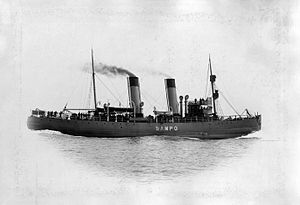Sampo (1898 icebreaker)

Sampo undergoing sea trials on 23 October 1898.
|
|
| History | |
|---|---|
| Name: | Sampo |
| Namesake: | Magical artifact from the Finnish mythology |
| Owner: | Finnish Board of Navigation |
| Port of registry: | Helsinki |
| Ordered: | 6 June 1897 |
| Builder: | Sir W.G. Armstrong, Whitworth & Co Ltd, Newcastle upon Tyne, United Kingdom |
| Cost: |
|
| Yard number: | 679 |
| Launched: | 21 April 1898 |
| Completed: | 25 October 1898 |
| Commissioned: | 15 November 1898 |
| Decommissioned: | 9 May 1960 |
| In service: | 1898–1960 |
| Identification: | IMO number: 5601174 |
| Fate: | Broken up in 1960 |
| General characteristics | |
| Type: | Icebreaker |
| Tonnage: | |
| Displacement: | 2,050 tons |
| Length: | |
| Beam: |
|
| Draught: | 5.6 m (18.4 ft) |
| Boilers: | Five coal-fired boilers |
| Engines: | Two triple-expansion steam engines, 1,200 ihp (890 kW) (bow) and 1,400 ihp (1,000 kW) (stern) |
| Propulsion: | Bow and stern propellers |
| Sail plan: | Equipped with sails |
| Speed: | 12.4 knots (23.0 km/h; 14.3 mph) in open water |
| Crew: | Initially 36, later 43 |
| Armament: | Armed during the Winter War |
Sampo was a Finnish state-owned steam-powered icebreaker. Built in 1898 by Sir W.G. Armstrong, Whitworth & Co Ltd in Newcastle upon Tyne, United Kingdom and named after a magical artifact from the Finnish mythology, she was the second state-owned icebreaker of Finland and the first European icebreaker equipped with a bow propeller. When Sampo was decommissioned and broken up in 1960, she was also the second last steam-powered icebreaker in the Finnish icebreaker fleet.
Prior to building Sampo, Finland had only one state-owned icebreaker, Murtaja, which was built in 1890 and was one of the first purpose-built icebreakers in the world. However, the 930-ton single-screw vessel was not powerful enough to keep even the southernmost port of Finland, Hanko, open during severe winters and the icebreaking characteristics of its spoon-shaped bow were not as good as was hoped for. A committee, appointed by the Senate of Finland in 1895 to find a solution to the problem, came to a conclusion that a second state-owned icebreaker would be needed.
In the 1890s the Senate sent two engineers and Leonard Melán, who later became the captain of Sampo, to investigate a new icebreaker design that had been developed in the United States in the 1880s and find out its icebreaking capability. Unlike the European icebreakers, the 1888-built train ferry St Ignace had two propellers, one at both end of the ship. Convinced about the superiority of the new design, the winter navigation committee recommended that the new icebreaker should be of the so-called "American type".
In February 1897 the Senate sent a request for tender to eight shipbuilders for the construction of a new icebreaker. On 6 June 1897 the contract was signed with Sir W.G. Armstrong, Whitworth & Co Ltd from Newcastle upon Tyne. While not the cheapest, the shipyard had the shortest delivery time — only seven months — for an icebreaker with bow propellers.
While the initial delivery date was 18 January 1898, Sampo was not delivered until October of the same year due to problems with material deliveries and strikes among the shipyard's workers. She was launched in the spring of 1898 and left for the first sea trials on 23 August. However, the bow propeller shaft seized shortly after leaving the dock and the icebreaker returned to the shipyard. The coal consumption was also 11% greater than what was specified in the contract, but instead of making changes the heating system the shipyard reduced the price by £700. The second sea trial on 21 September was successful and Sampo left for Finland on 25 October 1898 and arrived to Helsinki four days later.
...
Wikipedia
